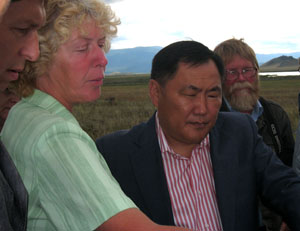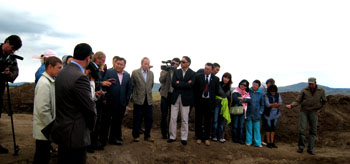|
 Just before the Archeologist’s Day, the leadership of Tuva, representatives of the Yenisei Industrial Company, organs of local administration, representatives of educational institutions, spent some time in the famous archeological complex of South Siberia, “Valley of Kings”, where a large number of kurgans from the Scytian times is concentrated, and where, according to plans, is the projected path of the Kuragino-Kyzyl railroad. Just before the Archeologist’s Day, the leadership of Tuva, representatives of the Yenisei Industrial Company, organs of local administration, representatives of educational institutions, spent some time in the famous archeological complex of South Siberia, “Valley of Kings”, where a large number of kurgans from the Scytian times is concentrated, and where, according to plans, is the projected path of the Kuragino-Kyzyl railroad. The main goal of this working trip was to verify the realization of the protocol decision of the interregional meeting, which took place on July 28 in Kyzyl under the chairmanship of the head of the republic, Sholban Kara-ool, with the participation of
 the chairman of the government of Krasnoyarsk Kray Edkham Akbulatov, the administration of Yenisei Industrial Company Boris Kabishchev and Aleksandr Brokert, and General director of the institute “SevZap Transproyekt”, Sergei Melnichenko. At that meeting, among other things, Kara-ool set up a task to take all possible measures for the protection of the cultural-historical heritage of Tuva during the realization of the railroad project. Special attention is to be paid to “Valley of Kings”. the chairman of the government of Krasnoyarsk Kray Edkham Akbulatov, the administration of Yenisei Industrial Company Boris Kabishchev and Aleksandr Brokert, and General director of the institute “SevZap Transproyekt”, Sergei Melnichenko. At that meeting, among other things, Kara-ool set up a task to take all possible measures for the protection of the cultural-historical heritage of Tuva during the realization of the railroad project. Special attention is to be paid to “Valley of Kings”.
The planners reacted promptly to this point of protocol, and re-designed the plans, leading the tract of the railroad away from the greatest concentration of kurgan burials in the “Valley of Kings”. The corrected tract was presented on August 8. To what extent this decreases the threat to the historical monuments was the question that Sholban Kara-ool evaluated on August 13, right at the location of the future railroad tract, with the archeologists and representatives of the private investor. Originally, the disputed zone on the territory of Tuva involved 56 groups of kurgans, which included more than 150 kurgans. After the correction of the project the zone still involves 21 burial complexes and 56 kurgans. Even though the tract immediately involves only a proportion of these monuments, the others are also under a threat of destruction, as the workers of the Institute of History of Material Culture (Sankt-Peterburg), Vladimir Semyonov and Marina Kilunovskaya, who participated at the request of the investor in the preliminary surveying of the territory for identification of the archeological monuments, believe.
 The archeologists showed a row of four smallish kurgans on the shore of White Lake to the Premier, which fall into the zone of the railroad. This is where a discussion broke out between the scholars and the director of Yenisei Industrial Company, and the state leadership. The basic dilemma was how to find a golden mean between two extreme positions: either dig up everything right away, or not to touch any of it at all. The archeologists showed a row of four smallish kurgans on the shore of White Lake to the Premier, which fall into the zone of the railroad. This is where a discussion broke out between the scholars and the director of Yenisei Industrial Company, and the state leadership. The basic dilemma was how to find a golden mean between two extreme positions: either dig up everything right away, or not to touch any of it at all.
“The most important thing is not to sacrifice the historical heritage of the nation to either economic advantages or to the interests of science., - emphasized Sholban Kara-ool. – These places hold evidence of the most ancient civilizations. And we must keep it for the future generations of Tuvans.”
 The evaluation was continued during a “Round Table”, discussion, which took place in the open-air museum “Valley of Kings”> The evaluation was continued during a “Round Table”, discussion, which took place in the open-air museum “Valley of Kings”>
“It is obvious that the railroad project is vitally important for socio-economic development of Tuva, - considers archeologist Konstantin Chugunov. –And it is not a question of some sort of prohibition of the construction. The main thing is that the investors understand their responsibilities for the future of these places. The very same railroad station “Arzhaan”, which is planned here, will also allow great numbers of people to get to know the rich historical heritage of Tuva. It is also important for the station to harmonize with the general landscape of “Valley of Kings”. All of this has to be planned into the smallest details.” Aleksandr Brokert confirmed the intention of the investor to take into account the archeological excavations and historico-cultural expert opinion evaluation in the second stage of planning, when putting together the Working documentation for the territory of the Kuragino-Kyzyl railroad tract.
Remember that the entire length of the railroad is 415 km, 133 of which transit through territory of Tuva. The project foresees the construction of 5 railway sidings, one intermediary station and 3 main stations, (Arzhaan, Kyzyl-cargo and Kyzyl-passenger). Surveying works are conducted through an area with complicated geologic engineering and geodesic-engineering conditions. 28 km of the projected tract transit through the lands of state forest fund. The most complicated segment is the area of Uyuk pass (332-360 km) where an ascent over a steep elevation of the extremely jagged north slope of Uyuk Ridge is foreseen.
According to the information of the general director OOO “SevZap TransProyekt”, Sergei Melnichenko, the planners recognize the necessity of preservation of the unique natural landscape and cultural-historical monuments on the territory of Tuva.
About the Valley of Kings.
The steppe around the settlement Arzhaan has attracted the attention of archeologists for a long time, as a place of concentration of the largest kurgans of the epoch of early nomadic peoples of Eurasia. The scientific works were first started in the Valley of Kings already in 1916, when the famous Russian researcher of Siberia, A.V. Adrianov excavated one of the kurgans.
The largest scientific resonance was brought about by the excavation of the famous kurgan Arzhaan, which was carried out in 1971-74 under the leadership of illustrious Leningrad scholar Mikhail Petrovich Gryaznov and Tuvan archeologist Mongush Khurguy-oolovich Mannai-ool. The materials recovered during the research of this colossal monument (diameter of 120 m, height 3-4 m). allowed a new appreciation not only of many questions of archeology of the Scythian period, but to form a more accurate idea of the formation of many impressive cultures of early nomads of Eurasia of the first millennium before our era. Most of the burials of the Valley of Kings that were excavated earlier had been subjected to grave robbers already in ancient times, and it was just barely possible to guess at the actual riches of these burials.
The expedition led by the Hermitage worker Konstantin Chugunov in 2001 discovered an untouched burial of the top of the nomadic nobility, which was later named Arzhaan-2. The kurgan had a diameter of 80 m, and was 2 m t high.
The choice of specifically this kurgan for excavation was determined by the fact that it was strongly damaged during the construction of a highway in 1960-70’s. The riches of the contents were astonishing.
Both the male and female were clothed in outfits decorated by almost 5 thousand of sewn-on small gold objects in the image of animals of the cat family. For the first time in archeologic practice, it became possible to determine the pattern in which the plaques were sewn onto the garment. The headdresses of both were decorated with gold images of horses, deer, panthers. The woman’s headdress was topped with long gold hairpins with engravings in the so-called Scythian Animal Style, topped by images, one of which was a remarkably worked sculpture of a standing deer. Around her neck and chest, there were earrings, many pendants and beads of gold,, turquoise, carnelian, and even amber. Around the man’s neck was a massive golden torc, the symbol of a ruler. The entire surface of this torc was decorated with images of animals – deer, wild boars, camels, tigers, wolves, which made it a sort of encyclopedia of the art of the nomads of Central Asia. The pants of the buried king were embroidered with delicate gold beads, the boots were covered with gold leaf. In front of the faces of the dead were bronze mirrors. In the corners of the burial chamber, on vertically arranged poles, was hanging the rest of the accompanying inventory.
Next to the woman, there was a golden pectoral, leather vessels with grains, a wooden scoop, and bronze and stone incense burners. Near the man, there was a ceremonial belt on which a bow and quiver, as well as a battle axe were fastened. It must be noted that all the weapons in the burial were made of iron, which was only beginning to be used at this time, and that is why, possibly, it was treasured more than gold by the nomads. The short akinak sword, knives, axe and also arrowheads were also decorated with gold. The recovered artifacts were restored in the labs of the State Hermitage, and in the summer of 2008, after insistent requests by the government of Tuva, were repatriated and returned to the National Museum of the republic. On November 2, 2008, a permanent exhibition “Gold of the Scythians”, was opened in Kyzyl.
|
|
